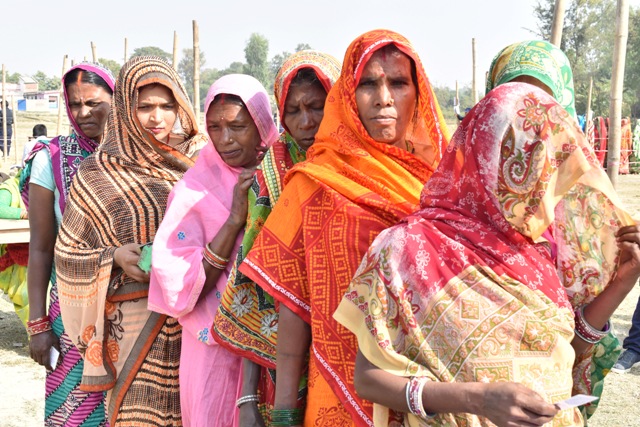Abducted Daylight (Part II)
4 years ago

4 years ago

4 years ago

4 years ago

4 years ago

4 years ago

File Photo/Republica
Case 1: She sets the baby down, it's excreted, pauses a second, wraps her shawl around her head, carries her baby and gets out. There are possibilities of the elder male members of the family being outside her room. She shouldn't be seen bare head. It is a symbol of disrespect towards the member. The baby yanks it down. She threatens the baby and hastily puts it in place. The temperature is 45 degrees outside. She's sweating like anything, but she has to cover her head.
Case 2: She has a bucket full of dung in one hand, a baby in another and the weight of the portion of cloth covering her head (pallu) on her head. She moves careful enough not to let it fall of the head. It is windy, wind sweeps her pallu down and it is no longer on her head. She puts the bucket down and sets the pallu in its place. This happens a dozen times on the way before she reaches home.
The other day I got to see some women in Bihar weep over the death of their sons because of Chamki Bukhar (Encephalitis) over a news channel. Even during such state of mourning and weeping, these ladies were constantly putting their pallus back on their head every time they fell down. If earthquake was to strike and the male members of the family were running, their first priority would still be to retain them on their head. Running would turn out to be the second priority.
Covering head is a cultural trait in a number of places in Asia. In Nepal, it can be seen predominantly in Madhesh. It is said to be a symbol of respect. This symbol of respect, however, has to be carried only by the daughter-in-law of the house. Despite the fact that a son respects his father and mother, a brother respects his elder brothers and elder sisters, a husband respects his wife, he is under no obligation to cover his head when making presence to these people. It only has to be a woman to do this. 'Respect,' thus, is merely a word decent enough to persuade the daughter in law of a house to do it.
Covering head is a redundant cultural trait coming from the ghunghat culture. The ghunghat culture that requires the daughter-in-law of the house cover her entire face within her sari veil, upon modernizing has taken this form. The custom of ghunghat might have been an effective strategy back then when child marriage was a norm. In a family consisting of a bride of 12, a bridegroom of 14, a brother-in-law of 16, a mother in law of 28 and a father in law of 32, there could be the possibility of the 32 years old father and 16 years old brother- in- law to be enticed by the 12 years old daughter-in-law. Ghunghat culture, can be seen as a defense mechanism for such daughter-in-laws. Ghunghatculture, though an effective means of defense then, is to be criticized for letting men the freedom of ease and laying on women an arrangement requiring difficulty apart from restricting her from making an identity of her own. Modernization spoke so much against ghunghat culture that it appeared to be almost impossible to go with this culture and the upholders of patriarchy reduced it to covering head.
Covering head is a powerful tool to ensure patriarchy and to endure it. To do household chores placing a shawl or sari pallu on head is not only a herculean task, but one that lays strong effects on psychology. The very moment a woman is being made to do this, she is being slowed, she is being vexed and she is being snatched away the freedom of movement. Covering head is not something that once done, will evade the responsibility of doing again. It is not a dress, which when worn once will not consist further handling throughout the day. It has been deliberately chosen to be something that will occupy major fraction of one's attention. It has been designed to fall every other second. It has been designed to fall every other minute even on the head of someone who has managed to live with it for years. The obligation to cover one's head upon an elder male's presence in her in-laws' house directs her brain to be focused toward his arrival every second of her day. It restricts her attention from being involved in other fruitful things. While it ensures she does not get to be independent, financially or intellectually, it makes the male member of the family feel empowered like an emperor. This is where the entire patriarchal system is rooted.
Also, there is a big kind of taboo associated with not covering head. One who chooses not to cover it is attributed to being uncultured, uncivilized and everyone in her parent's house are called names. The entire grip is so deep-seated. The fear of having to hear parents being accused of uncivilized, or that of divorce leads her do it and even she, who dared to revolt against elements of suppression, falls a victim of it.
What is surprising is the fact women play a greater role in enduring it. A woman comes to be the greatest hindrance whenever a woman decides not to go with it. The existence and the continuity of it rests on important psychological aspects. A woman who has done it all her life, out of malice cannot bear another woman not do it. Even a slight inclination toward understanding the other person's notion is likely to make her realize the absurdity of it. She will be ready with a sword-like thing in her consciousness as realization of its vainness will fill her with regrets. Her only element of pride has been the fact that she has covered her head all her life. Out of an attempt to preach of her greatness, she will prevent most of the women from not covering it. It is not funny how these ladies that never possessed sense or guts enough to question its validity, who blindly went with the custom, suddenly become so powerful as be the runner of the custom. It's amazing how politeness, gentility and care cease to be the symbol of respect and covering head stands in its place.
From what I have observed and studied, a technique that will properly set the pallu on head and evade the trouble of having to manage it every other second will be loathsome to the so-called elder people in the house. Though, unaware, these people do have a deep-seated desire to get women make some rush and some hastened movement upon their arrival. A well-arranged pallu on head, therefore, does not represent as much respect as does one that has to be hastily arranged upon the man's arrival. Such are the yearnings of patriarchy.
It is pathetic that the male counterparts have to restrict their women's movement in order to feel powerful and it is pathetic that women act as greater upholders of patriarchy. Unlike some other gestures from the past that does contribute to physical or mental wellbeing of a person, this gesture is merely a gesture promoting the ruthless aspects of patriarchy.

- by RAKHI BIND

- by Republica

- by Bishakha Koirala

- by Divya Adhikari
Leave A Comment